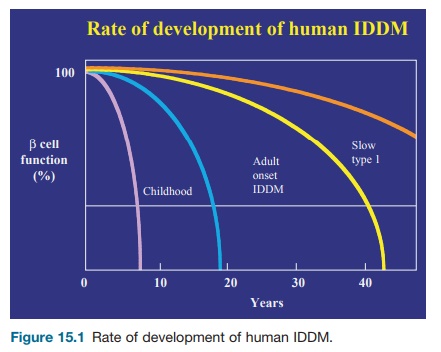Chapter: Essential Clinical Immunology: Immunological Aspects of Endocrine Disease
Insulin-Dependent Diabetes Mellitus
INSULIN-DEPENDENT DIABETES MELLITUS
IDDM is a T-cell-mediated autoimmune disease. Its etiology is multifactorial, involving several predisposing genes and complex environmental factors. The analy-sis of disease pathogenesis and the search for new treatments have benefited enor-mously from the availability of two spon-taneous animal models of the disease:
(1) the nonobese diabetic (NOD) mouse and
(2) the bio-breeding (BB) rat.
CLINICAL PRESENTATION
Most commonly, IDDM starts suddenly in a previously healthy individual, usually a child. The initial clinical symptoms include polyuria and polydipsia as a consequence of osmotic diuresis induced by glycosuria. If the disease is not diagnosed early, weight loss is observed, and in some cases keto-acidosis, leading to coma. The biological hallmarks of the disease are hyperglycemia and glycosuria. The treatment is based on the regular administration of exogenous insulin in doses and with a timing adapted to each individual patient. Once it has appeared, insulin dependency is defini-tive, as explained by the complete destruc-tion of β cells, the insulin-producing cells in the islets of Langerhans of the pancreas in patients with longstanding disease. In some patients, however, the disease may regress for a few months after initiation of intensive insulin therapy (the so-called honeymoon). This remission is linked to the relief of B cells from glucotoxicity.
An important and yet unsettled ques-tion is the percentage of β cells that are still alive at the time of diagnosis. This is a cru-cial question for immunotherapy strategies. Only limited data are available in human IDDM, since pancreas biopsies have only

occasionally been performed because of the risk of biopsy-induced pancreatitis. Data obtained in the NOD mouse indicate, how-ever, that before being destroyed, β cells show reversible signs of inflammation.
IDDM usually starts abruptly in most patients. However, IDDM may be preceded by a long phase of non-insulin-depen-dent diabetes (latent autoimmune diabe-tes of the adult, or LADA). It is generally assumed that LADA represents a slowly progressing form of autoimmune diabetes (see Figure 15.1).
Related Topics